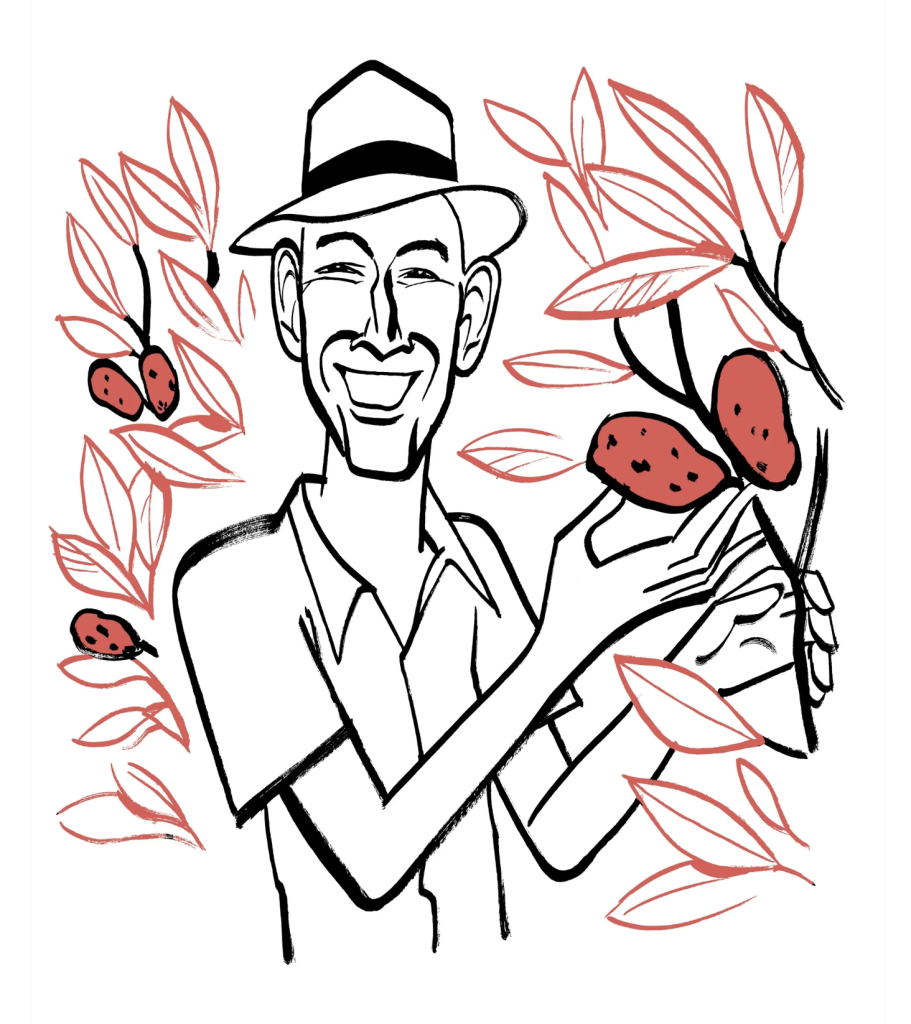Read on at The New Yorker
Michael Judd visits a rooftop garden in Brooklyn to evangelize about the pawpaw, which, if he has anything to say about it, is set to become the next hot fruit.
From mid-August to early October, Michael Judd, an edible-landscape designer from Maryland, eats almost nothing but pawpaw, a creamy mango-shaped fruit that tastes like candied banana. He loves pawpaw crème brûlée, pawpaw panna cotta, lasagna with black beans and pawpaw. When pawpaw season is at its height, as it is now, he spends so much time harvesting that he barely has any time for meals. “I’m so busy—I go out and I just keep going, but I eat pawpaw,” Judd said one warm evening not long ago. “I’ll eat two or three pawpaws, and I can completely run and fully function and work. I’m very sensitive to what I eat and my energy, so from that alone I can tell you it’s a really strong, complete food.”
Judd, who lives with his family on a twenty-five-acre permaculture homestead in the foothills of the Blue Ridge Mountains, was arranging some chairs on a rooftop garden in Red Hook. He was in town to host a group of about twenty horticulturists, urban farmers, agricultural scientists, and pawpaw devotees, who’d come for a “pawpaw-ice-cream party” and to hear some evangelizing about pawpaws. Six of the guests had never tried the fruit before. The berry, America’s largest native edible tree fruit, grows wild and plenty in twenty-six states, but it’s almost never in grocery stores.
The pawpaw-curious arrived and sat in a semicircle around Judd. Most wore pragmatic outfits: orthopedic sandals, waterproof ankle boots, dirty trousers. Judd, who is forty-eight, with pointed features, sipped on pawpaw mead. “I’m a modern-day pawpaw ambassador,” he said. “Pawpaws for the people! It’s a movement.” He explained that he’d lived for twenty years in Latin America, mostly in Nicaragua, where he became interested in equatorial plants. “I grew a lot of the tropical relatives of pawpaws,” he said. When he returned to Maryland, in 2010, he noticed, for the first time, pawpaws hanging from trees. “I come back to live here, and all of a sudden there’s this tropical-looking fruit growing near me,” he said. “There are more than two thousand species in the custard-apple family, and the pawpaw is the one that said, ‘I’m going north.’ ” Judd invited the guests to share their own pawpaw experiences.
“First time I had a pawpaw was about an hour ago,” Maya Kutz, the greenhouse manager at a rooftop farm, called out.
“The first one I tried was too ripe,” a woman with big dark-brown curls said. “And I didn’t like it at all.”
“As a fruit, it’s very perishable,” Judd said. “Remember this: freeze ’em. Then peel it like a potato.” He explained the stages of ripeness: rock hard on the branch, then softer, like a peach, when it’s time for picking. After about five days in the fridge, he said, “it’ll go a little bit richer and caramelized, almost like coffee.”
A young man wearing glasses interrupted to ask for advice on germinating seeds that he was storing in his fridge. “I just want to know: Is it, like, as easy as dropping seeds in Central Park?” he said. (Not quite.)
A man wearing a metal meditation pyramid over his head asked, “Have you ever had pawpaw juice?”
“Juice?” Judd responded. He sounded indignant.
“I find it much easier to find other exotic fruits,” a bearded man, sitting cross-legged on the ground, said. “I couldn’t find pawpaws anywhere.”
“You will soon,” Judd said. He added that in the past five years small orchards along the East Coast have started growing pawpaws, and that pawpaw festivals have popped up in Ohio, Maryland, Pennsylvania, and North Carolina. Scientists in Kentucky are seeking to extend pawpaws’ shelf life to make growing them on a large scale economically viable. Judd said, “It’s hot. It’s coming up. It’s of interest.”
“A word of warning,” the man with glasses said. He has dried pawpaws into a fruit leather: “They are the tastiest laxative I’ve ever had.”
“It’s like cleansing,” Judd said. “You wanna go slow with it.”
As the talk wrapped up, Kutz, the greenhouse manager, asked if Judd would help plant some pawpaw trees. Kutz dug two holes in a wooden planter box. Judd set down two delicate trees. He gingerly clipped away some of the leaves. “That will deal with the shock of transplantation,” he said. “It’s like being born.” After making sure that the plants were steadily rooted, Kutz and Judd headed down the street toward Red Hook Channel, hoping to catch the sunset. Judd inspected the trees lining the street. Pawpaws? “Mulberries,” he said. “Mulberries everywhere.” ♦
Posted In: Edible and Ecological Landscape Design, Media

